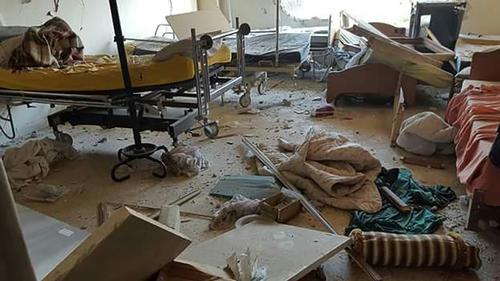Makeshift hospitals supported by Médecins Sans Frontières (MSF) have reported a series of extreme mass-casualty influxes resulting from 20 consecutive days of intense bombing attacks in August on markets and civilian buildings in the besieged communities of East Ghouta, near the Syrian capital. At least 150 patients per day have been treated for war wounds during this period. In parallel, the stranglehold of siege tactics has been both tightened and expanded, with three areas to the north of Damascus, where at least 600,000 people live, newly put under siege.
13 makeshift hospitals that MSF supports in the East Ghouta besieged area report being almost permanently overwhelmed with violent trauma cases from 12 to 31 August. MSF has precise data for the mass casualty influxes at six hospitals, revealing 377 deaths and 1,932 wounded. 104 of the deaths and 546 of the wounded were children under fifteen years old - approximately one in four of the victims. Because the intensity of the bombing has temporarily cut some communication channels, MSF does not yet have the full detailed breakdown of figures from the remaining MSF-supported medical facilities.
“This is one of the bloodiest months since the horrific chemical weapons attack in August 2013,” says Dr Bart Janssens, MSF Director of Operations. “It is clear that there were at least 150 war-wounded treated per day in East Ghouta during these 20 days of bombing. The hospitals we support are makeshift structures, where getting medicine is a dangerous and challenging endeavour, and it is unthinkable that they would have been able to cope with this intensity of emergency trauma response with such constraints. The Syrian doctors’ continued unswerving effort to save lives in these circumstances is deeply inspiring, but the situation that has led to this is totally outrageous.”
At the same time, the sieges around Damascus have both tightened and expanded. Three new areas to the north of Damascus - All Tall, Hameh and Qoudsaaya – where at least 600,000 people live have been newly put under siege since 22 July. This means that people are stopped and searched and no medical supplies, food, fuel or other basic essentials are allowed in. And the already-strict siege on areas such as Mouadamiyieh has tightened, meaning that not only are medical items and food blocked, but now all pedestrian traffic in and out is completely impossible. Now more than ever medical evacuations out of most besieged areas are impossible, even for patients who urgently need technically advanced life-saving medical attention.
“The stranglehold of siege means these communities are being deprived of the basic goods that are essential to their survival,” says Dr Janssens. “We are aware of around 400 amputations conducted in East Ghouta in August. Many of these people’s limbs could have probably been saved if the medical care in besieged areas were not so desperately constrained. Via the medical networks we are still able to get medical supplies through the siege lines, but it is becoming increasingly difficult.”
MSF is urgently organising resupply of essential medical items to replenish exhausted pharmacy stocks, including more than 5,000 IV fluid pouches and 1,500 pouches of blood.
Four million Syrians have fled Syria and millions are refugees in neighbouring countries, while thousands are risking death and detention on the way to Europe. Approximately two million people are under siege in places like East Ghouta where violence and deprivation of basic life necessities are the daily reality.
“August was the worst month we’ve seen medically,” says an MSF-supported hospital director in one of the besieged areas. “Anyone who isn’t injured or dead can count themselves lucky. Enough death and siege. Enough blood and misery. Enough.”
MSF operates six medical facilities in the north of Syria and directly supports more than 100 health posts and field hospitals throughout the country, with a particular focus on the besieged areas. These are mostly makeshift facilities with no MSF staff present, where MSF provides both material support and distance training support to help the Syrian medics cope with the extreme medical needs. This support network has been built up over the past four years.




